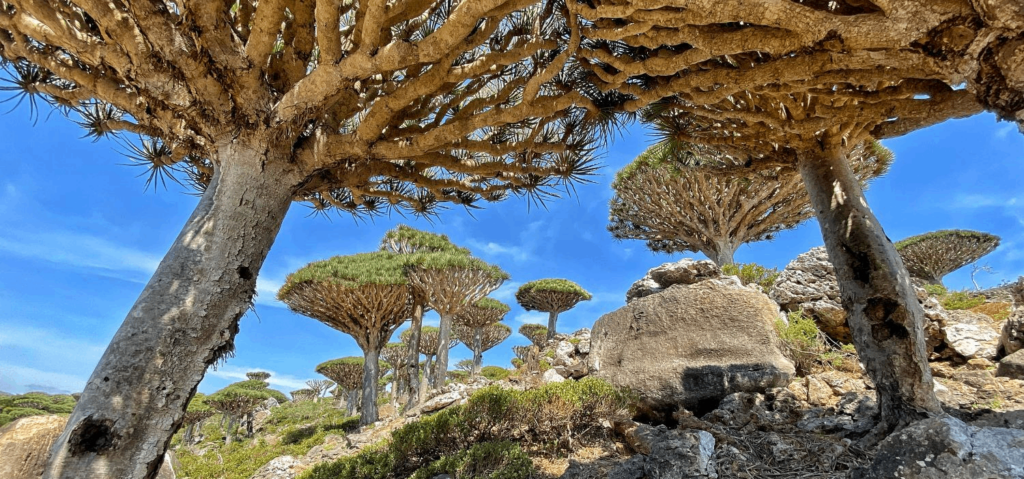Nestled in the Arabian Sea, Socotra Island is a remarkable natural wonder. Known as the “most alien-looking place on Earth,” it captivates visitors with its extraordinary biodiversity and striking scenery. This Yemeni treasure boasts a plethora of endemic plant species, creating a surreal landscape that seems like it belongs to another world.
Dragon’s Blood Tree: A Natural Icon
The Dragon’s Blood Tree, scientifically known as Dracaena cinnabari, dominates Socotra’s landscape. Its unique umbrella-shaped canopy and thick branches create a mesmerizing silhouette against the horizon. This ancient tree produces crimson resin, often referred to as dragon’s blood. Historically, people have used this sap for medicine, dye, and even rituals. Today, it remains a symbol of Socotra’s incredible biodiversity and continues to fascinate scientists and tourists alike.
Desert Rose: Sculpted by Nature
Another standout plant on Socotra is the Desert Rose, or Adenium obesum socotranum. Its bulbous trunk serves as a water reservoir, enabling the plant to thrive in the island’s arid climate. The Desert Rose blooms with striking pink flowers, adding vibrant color to the rugged terrain. Its ability to adapt and flourish in harsh conditions makes it a testament to nature’s ingenuity.

Cucumber Tree: A Curious Evolution
Among Socotra’s botanical wonders is the Cucumber Tree, Dendrosicyos socotranus. As a member of the cucumber family, it has evolved into an unusual tree form found only on the island. Its thick, bottle-like trunk and sparse greenery make it instantly recognizable. The tree thrives in the rocky, dry environment, standing as a symbol of life’s resilience.
Frankincense Trees: Aromatic Heritage
Socotra also harbors several species of Frankincense trees, known as Boswellia spp. These trees have been sources of aromatic resin for centuries, fueling ancient trade routes and cultural connections. Their distinct appearance and historical significance make them an integral part of Socotra’s allure. Today, their conservation remains critical to preserving the island’s unique cultural and natural heritage.
Unmatched Biodiversity and Global Importance
Socotra’s flora is unmatched in its diversity and endemism. With over a third of its 825 plant species found nowhere else, the island is a hotspot for botanical research. Organizations and researchers have worked tirelessly to document and protect this unique ecosystem. UNESCO recognized the Socotra Archipelago as a World Heritage Site, emphasizing its ecological significance and the importance of conservation efforts. Protecting these fragile ecosystems is vital not just for Yemen but for the global community.
A Journey Worth Preserving
Exploring Socotra is like stepping into another world. Its alien-like plants and serene environment offer a unique escape from the ordinary. However, the island’s fragile ecosystem requires careful management to ensure its beauty and biodiversity endure for future generations. Local and international conservation programs play a crucial role in safeguarding Socotra’s treasures.
Conclusion
Socotra Island stands as a living testament to nature’s creativity and resilience. Its endemic plants, like the Dragon’s Blood Tree and Desert Rose, highlight its exceptional biodiversity. As more visitors discover this hidden gem, it becomes increasingly essential to protect its fragile ecosystem. Socotra’s alien landscape is not only a visual marvel but also a reminder of our shared responsibility to preserve the planet’s most extraordinary places.
